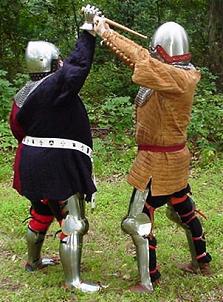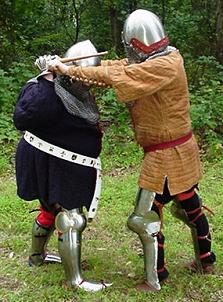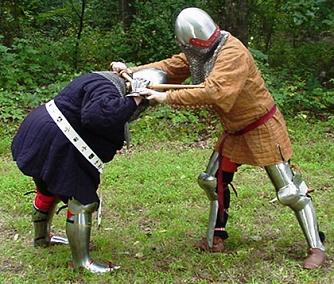
| Home |
| About Us |
| Instruction |
| Source Material |
| Links |
| Contact Us |
Figure 1
Figure 2

 This play starts just as before, but this time it is Hugh who passes forward to strike an Oberstich at Dave’s face.
This play starts just as before, but this time it is Hugh who passes forward to strike an Oberstich at Dave’s face.
In figure 1, Dave lunges forward with his left foot and displaces Hugh’s attack with an Upper Shield.
In figure 2, Dave pushes his dagger back over Hugh’s head; note that because Dave applied constant pressure from the moment he made the displacement Hugh’s dagger is still caught on Dave’s dagger.
In figure 3, Dave passes back and uses the strength of his arms plus the power of his step to pull Hugh forward.
 As soon as Hugh is unbalanced Dave would automatically push straight downward to drive Hugh to the ground.
As soon as Hugh is unbalanced Dave would automatically push straight downward to drive Hugh to the ground.
This play works so well because human arms have little strength to resist a backward push when they’re up in the air, so the initial hook is actually quite easy to do. And since the victim will be pushing forward to resist, he’s also very easy to pull forward when his head is hooked. Note, too, that the reason Dave is doing the technique in these pictures is that it’s very hard to use this technique against a much taller person, particularly one wearing a tall helmet. (Wallerstein Codex, fol. 24 v)
copyright 2009 Hugh T. Knight, Jr. All rights reserved.